OUTLINE:
Which filament is best for 3D printing
 364
364A successful print or a frustrating endeavor could be determined entirely by the filament choice used in the quickly developing field of additive manufacturing. The search for the best filament for 3-D printing requires in-depth knowledge of fabric houses' print settings and purported use cases because there are a plethora of options available each with unique qualities and applications.
The range of 3-D printing filaments is wide and diverse ranging from the eco-friendly and user-friendly PLA (Polylactic Acid) to the high-electricity ABS (Acrylonitrile Butadiene Styrene) needed for functional prototypes and mechanical components. factors are crucial in determining whether a filament is appropriate for a given assignment along with filament diameter filament first-rate print temperature bed adhesion and submit-processing requirements.
Moreover, advancements in filament technology have made materials like PETG (polyethylene terephthalate glycol) and TPU (thermoplastic polyurethane) possible. Each of these materials has special advantages such as durability, flexibility, and chemical resistance. Whether they are creating intricate artistic designs, sophisticated prototypes, or useful mechanical parts, makers can select the ideal filament for their projects by being aware of these subtleties.
To offer a thorough overview of the world of 3D printing filaments this article on Which filament is the best for 3D printing? We aim to equip novices and experienced enthusiasts with the necessary knowledge to attain remarkable outcomes in their 3D printing pursuits by examining the advantages, disadvantages, and ideal uses of diverse materials. To get the most out of your 3D printer regardless of your goals—sustainability, affordability, strength, or precision—you need to understand the qualities of a good filament.
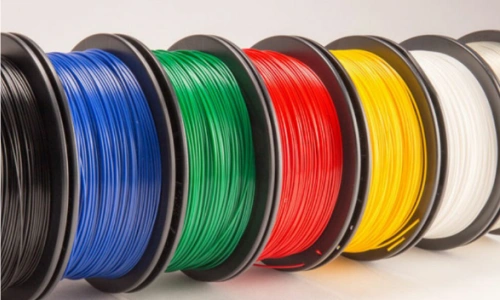
Image Source: 3Dnatives
What is a 3D printing filament
In fused deposition modeling (FDM) and other related additive manufacturing processes a 3D printing filament is the substance that is used to build three-dimensional objects layer by layer. Typically filaments are made of long strands of thermoplastic polymers but in certain sophisticated applications, they can also contain metals or composite materials.
After being heated to melting in a 3D printer these filaments are fed into a build platform where they are extruded through a nozzle. The extruded material forms layers that progressively assemble to form the desired object as it cools and solidifies. The final prints' strength, flexibility, durability, and aesthetic qualities are all influenced by the filament material selection.
Typical types of 3D Printer Filament are PLA (polylactic acid) ABS (acrylonitrile butadiene styrene) PETG (polyethylene terephthalate glycol) TPU (thermoplastic polyurethane) and nylon. Each has special qualities that make it appropriate for a variety of uses from manufacturing and prototyping to artistic and educational endeavours.
Which filament is the best for 3d printing
The best filament for 3D printing will depend on some things such as your preferences for material properties, the particular requirements of your project, and the capabilities of your 3D printer. These are some common filament choices along with their usual applications:
1. PLA
Polylactic acid or PLA is one of the most well-liked and extensively used filaments in 3D printing for several strong reasons:
- Usability: PLA is renowned for being very simple to print on. It usually sticks to the print bed nicely without the need for a heated bed though some users find that a heated bed between 50 and 60°C improves adhesion). It’s perfect for use in homes and educational settings because it doesn’t warp too much and doesn’t smell bad when it prints.
- Biodegradability: Sugarcane and corn starch two renewable resources are the sources of PLA meaning that in the right conditions (e. g. locations for composting). This eco-friendly feature will appeal to users who are conscious of their environmental impact.
- Variety: The color and texture of PLA are very diverse ranging from glossy matte to translucent finishes and even metallic or marble-like textures. Creative freedom is flexible enough to produce eye-catching prints. Although PLA is not as strong as materials like ABS or nylon it still has sufficient strength and rigidity for a range of applications including prototypes, decorative items, and parts that are not subjected to high mechanical stress.
- Novices: Because PLA prints more easily and is less likely to cause issues like warping or nozzle clogging it is often recommended for individuals who are just getting started with 3D printing.
- Applications: PLA is frequently used in a variety of industries for prototyping architectural models, toys, figurines, educational projects, and consumer goods. Because of its wide range of vibrant colors and ability to capture minute details, it is a popular choice for creative and ornamental prints.
Overall many 3D printing enthusiasts and professionals choose PLA because of its blend of biodegradability, variety, ease of use, and versatility; this is especially true for projects where environmental impact and aesthetic appeal are critical considerations.
Although PLA (polylactic acid) is a widely used material for 3D printing there are a few drawbacks and things to keep in mind.
- Low Heat Resistance: When compared to materials like ABS or PETG PLA has a comparatively low heat resistance. Because it tends to soften and distort at 50–60°C it is not recommended for use in applications requiring high-temperature stability.
- Brittleness: PLA can be brittle particularly in cold environments or when printed with thin walls. This brittleness can cause problems, especially in functional parts that are subjected to mechanical loads such as breaking or snapping under stress.
- Moisture Sensitivity: Over time PLA may take up moisture from the air which may have an impact on the performance of the filament and print quality. Moisture-absorbed PLA requires careful storage in a dry environment because it can result in prints with irregularities like bubbles or uneven surfaces.
- Problems with Biodegradability: Although PLA decomposes in industrial composting environments the absence of certain necessary elements may prevent it from breaking down in residential compost bins or landfills. g. warmth and microbiological activity). This restricts the entire environmental benefit unless it is disposed of in designated facilities.
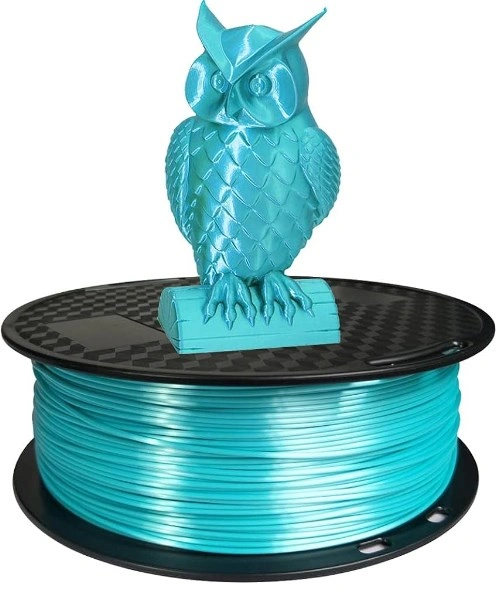
2. ABS
Acrylonitrile Butadiene Styrene or ABS is a popular filament for 3D printing that is renowned for its adaptability and durability. Certainly! ABS (Acrylonitrile Butadiene Styrene) has several advantages that make it a popular choice for 3D printing:
- Strength and Durability: ABS is appropriate for functional parts, mechanical components, and prototypes that need to be durable due to its strength, toughness, and impact resistance.
- Heat Resistance: ABS is better at withstanding heat than PLA which makes it appropriate for applications requiring thermal stability or exposure to higher temperatures.
- Post-Processing: Methods like painting sanding and acetone vapor smoothing are simple ways to post-process ABS. As a result, prints can have smoother finishes and more appealing visual elements.
- Flexibility: Automotive components electronic housings household goods and industrial prototypes are just a few of the many uses for ABS.
- Chemical Resistance: ABS has a strong resistance to solvents and chemicals which makes it appropriate for uses where there may be a risk of chemical exposure.
- Mechanical Properties: The mechanical strength and good layer adhesion of ABS prints ensure dependable performance in a range of demanding applications.
- Weldability: ABS can be joined to form larger assemblies or intricate designs by using techniques such as acetone welding.
- Accessibility: There is a large range of colors and formulations of ABS filament available including ones that have additives added for improved qualities like UV or impact resistance.
Because of these benefits, ABS is a material of choice for those who want to create functional long-lasting parts that can withstand harsh conditions and have good mechanical qualities. When choosing the best filament for your particular project it's crucial to take into account the disadvantages and challenges that come with ABS such as printing issues and environmental concerns.
But there are also some disadvantages and things to keep in mind:
- Printing Difficulty: ABS shrinks and warps when it cools making it difficult to print with. To ensure uniform temperature and reduce warping it needs a heated print bed (between 90 and 110°C) and an enclosed print chamber is frequently advantageous.
- Emissions: When ABS is printed it releases fumes that may be hazardous such as styrene which is irritating to the eyes and respiratory system. To guarantee safety ABS printing needs to be done in a space with adequate ventilation or with a fume extraction system.
- Smell: When printing ABS releases a noticeable and occasionally disagreeable smell that could be problematic in small or enclosed areas.
- Post-Processing: ABS can be trickier to post-process than PLA even though it yields prints that are robust and long-lasting. Because of the matte surface and visible layer lines, sanding and painting might be necessary to get a smooth finish.
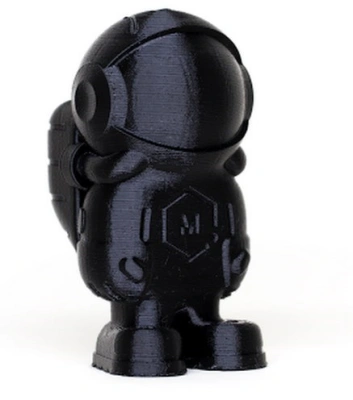
3. PETG
PETG (Polyethylene Terephthalate Glycol) filament finds a happy medium between PLAs ease of printing and ABSs robustness. Because of its strong layer adhesion, low warping, and superior chemical resistance, it is the perfect material for mechanical components and functional parts that need to be resilient and strong.
- Easy to Print: PETG is more forgiving to print than ABS because it combines the PLA-like ease of printing with superior toughness and durability.
- Durability: PETG is a good material for functional parts and mechanical components that need to be strong and resilient because of its exceptional durability and impact resistance.
- Very Little Warping: Because PETG clings well to the print bed and shrinks less quickly than ABS it experiences very little warping when printing.
- Chemical Resistance: PETGs strong resistance to solvents and chemicals makes them more suitable for applications where exposure to these types of environments is necessary.
- Transparency and Aesthetic Appeal: PETG comes in transparent and translucent forms providing a glossy finish for eye-catching prints.
- Environmental Impact: PETG is recyclable which when handled appropriately can support sustainability initiatives even though it is not biodegradable like PLA.
Talking about the cons:
- Stringing: When printing PETG is prone to stringing or oozing so print parameters like retraction distance and speed must be carefully adjusted.
- PETG is less compatible with some 3D printers or may need to be modified due to its higher printing temperature sensitivity (typically between 230 and 250°C) when compared to PLA.
- In thin sections or when subjected to sharp impacts PETG can display brittleness similar to other plastics albeit less so than PLA.
- Challenges with Post-Processing: PETG is susceptible to stringing so it may take more work to achieve a smooth finish than PLA or ABS. However, PETG can be post-processed with sanding and polishing.

4. TPU
Rubber-like elasticity and high resistance to impact and abrasion are two of TPU (Thermoplastic Polyurethane): filament's most well-known qualities. TPU is a material that is frequently used to create flexible parts such as phone cases, seals, and gaskets. In applications where mechanical flexibility is crucial TPU offers remarkable resilience and durability.
- Flexibility: TPU is incredibly elastic and flexible possessing characteristics similar to rubber that let it stretch and bend without breaking.
- Impact Resistance: Because TPU has a high level of abrasion and impact resistance it can be used in applications that call for durability and shock absorption.
- Chemical Resistance: TPU is resistant to oils, greases, and chemicals which increases its durability in harsh settings.
- Ease of Printing: TPU is versatile but with the right settings it can be printed successfully on a wide range of desktop FDM printers making it useful for a number of applications.
- TPU is widely utilized in industrial applications where mechanical resilience is essential as well as for flexible parts like wearables, gasket seals, phone cases, and other flexible components.
TPU is very flexible and durable but there are a few things to keep in mind. Printing Challenges:
- To reduce problems like stringing and bed adhesion TPU prints better with particular print settings and adjustments (like slower print speeds and precise temperature control).
- The flexible nature of TPU makes it difficult to adhere to the print bed frequently requiring the use of specialized adhesion aids or surfaces.
- Compatibility Issues: Because TPU has special printing requirements and flexibility some 3D printers may need to be upgraded or modified in order to handle it effectively.
- Cost consideration: TPU filaments are typically more expensive than PLA or ABS standard filaments which could affect certain users' ability to complete their projects within their budgets.
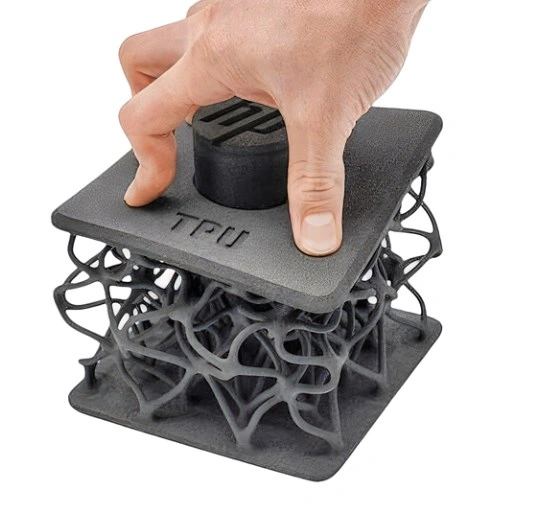
5. Nylon
The remarkable strength, flexibility, and resistance to chemicals and abrasion of nylon filaments are well known. It is preferred in 3D printing for creating strong useful parts and mechanical components that must withstand high stress and withstand a long time.
- Strength and Durability: Because of its remarkable strength and toughness nylon is a good choice for parts that must be able to withstand impact and mechanical stress.
- Flexibility: Nylon is a good material for resilient parts and functional prototypes because it is flexible enough to bend and recover without breaking.
- Chemical Resistance: Nylon is well-suited for industrial applications where exposure to abrasive environments is frequent because of its strong resistance to oils, greases, and some chemicals.
- Printability: While nylon tends to absorb moisture and requires specific drying and print settings making it more difficult to print than PLA or ABS improvements in filament quality have made nylon more widely available for desktop 3D printing.
Cons:
- Moisture Absorption: The mechanical properties and print quality of nylon filament can be adversely affected by the absorption of moisture from the air. Using the right drying and storage methods is essential to reducing this problem.
- Printing Difficulty: To achieve proper adhesion nylon may require a heated build platform and higher print temperatures. Furthermore, during printing, it tends to warp which calls for precise calibration and maybe an enclosed print chamber.
- Cost: The costlier nature of nylon filaments compared to PLA or ABS filaments may affect certain users' ability to complete their projects within their budgets.
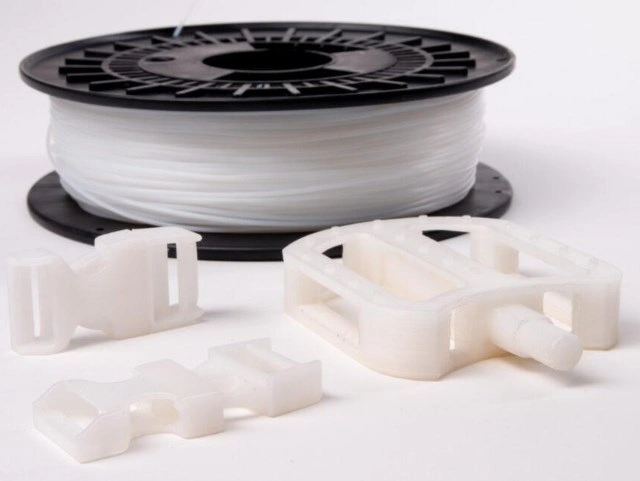
6. Specialty Filaments (e.g., Wood, Metal, Carbon Fiber)
To improve their qualities and provide distinctive texture finishes or greater strength for specific 3D printing applications specialty filaments combine additives like wood fibers, metal powders, or carbon fibers.
- Enhanced Properties: Specialty filaments with additives like wood fibers, metal powders or carbon fibers have characteristics like a metallic finish, a wood-like texture, or greater strength.
- Aesthetics: By enabling the production of eye-catching prints with distinctive textures and finishes these filaments improve the printed objects' aesthetic appeal. Practical
- Uses: These materials are appropriate for uses requiring particular characteristics like heat resistance conductivity or increased mechanical strength.
- Versatility: By utilizing distinct material properties specialty filaments expand the possibilities for 3D printing enabling innovative designs and useful prototypes.
Cons:
- Availability: Depending on your location and the availability of suppliers the availability of specialty filaments may be more constrained than that of common filaments like PLA or ABS.
- Cost: Due to the expense of additives and production procedures specialty filaments are typically more costly than regular filaments like PLA or ABS.
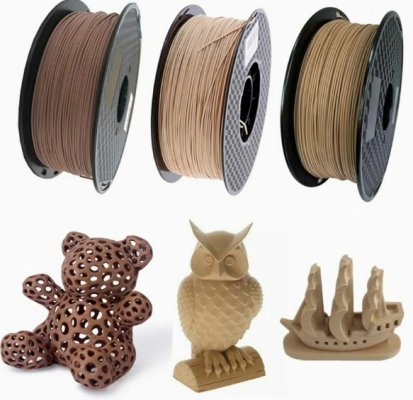
FAQs
What aspects should I take into account when selecting a filament for my 3D printer?
One must take into account the intended use (e. g. G. the material's qualities (strength flexibility durability) printability (adhesion warping) cost and environmental impact (biodegradability recycling) among other factors.
How do PLA and ABS filaments differ from one another?
PLA is biodegradable, simpler to print with, and appropriate for intricate prints and decorative objects. For functional parts and mechanical components, ABS is better because it is stronger, more resilient, and heat-resistant. However, because of emissions, it needs a heated print bed and adequate ventilation.
When is the best time to use PETG film?
PETG is advised for uses where minimal warping strength and durability are required. This material blends the durability of ABS with the printing ease of PLA making it ideal for mechanical parts, functional parts, and items subjected to mild stress and chemicals.
What are the advantages of nylon filament application?
For functional parts and components that need to be resilient under pressure nylon filament is the perfect choice because of its remarkable strength, flexibility, and chemical resistance. Applications in the engineering aerospace and automotive sectors are appropriate for it.
What impact does print quality have from specialty filaments like carbon fiber metal and wood?
To improve characteristics like texture finish or strength specialty filaments can include additives like carbon fibers, wood fibers, or metal powders. Although they may need to have print parameters changed and can be more expensive than standard filaments they can produce distinctive aesthetics and enhance mechanical properties.
What drawbacks are there when using TPU filament?
TPU filament is appropriate for applications needing flexibility and durability because it is resilient to impact and abrasion. But because it's flexible printing it can be difficult. You'll need to use special print parameters and adhesion techniques and it might be more expensive than more rigid filaments like PLA or ABS.
How can the problems with nylon filaments' absorption of moisture be minimized?
To stop moisture from seeping in, keep nylon filament dry and sealed in a container filled with desiccant packets. To minimize print quality issues and restore ideal printing conditions, dry the filament in a specialized filament dryer or oven at a low temperature before printing.
Which 3D printers can use specialty filaments?
Compatibility varies according to the particular additive and filament makeup. To ensure successful printing and maintain print quality some specialty filaments may need to be upgraded or modified in the 3D printer (such as adding an enclosure or upgrading the nozzle).
Conclusion
Understanding the special qualities and uses of each material is essential to selecting the best ideal filament for your 3D printing projects. Each offers unique benefits suited to particular needs from industrial applications and functional parts to prototyping and functional parts. These needs range from the user-friendly PLA to the robust ABS versatile PETG resilient nylon and inventive specialty filaments.
You can select a filament that best suits the requirements of your project by taking into account variables like strength, flexibility, durability, printability, environmental impact, and cost. The wide variety of available filaments allows you to explore new possibilities and achieve exceptional results in your 3D printing endeavors regardless of your preference for mechanical strength, ease of use, or aesthetic appeal.
The best filament ultimately comes down to your personal needs and preferences. Using your understanding of printing methods and filament properties in conjunction with experimentation will help you choose the best filament to improve the creativity and quality of your printed goods.

Disclaimer: The views and opinions expressed by individual authors or forum participants on this website do not represent the views and opinions of Chipsmall, nor do they represent Chipsmall's official policy.

share this blog to:

